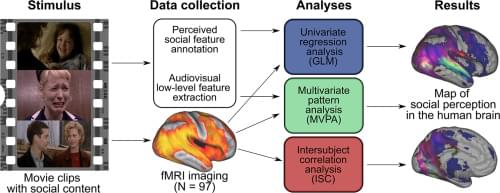Humans rapidly extract diverse and complex information from ongoing social interactions, but the perceptual and neural organization of the different aspects of social perception remains unresolved. We showed short movie clips with rich social content to 97 healthy participants while their haemodynamic brain activity was measured with fMRI. The clips were annotated moment-to-moment for a large set of social features and 45 of the features were evaluated reliably between annotators. Cluster analysis of the social features revealed that 13 dimensions were sufficient for describing the social perceptual space. Three different analysis methods were used to map the social perceptual processes in the human brain. Regression analysis mapped regional neural response profiles for different social dimensions. Multivariate pattern analysis then established the spatial specificity of the responses and intersubject correlation analysis connected social perceptual processing with neural synchronization. The results revealed a gradient in the processing of social information in the brain. Posterior temporal and occipital regions were broadly tuned to most social dimensions and the classifier revealed that these responses showed spatial specificity for social dimensions; in contrast Heschl gyri and parietal areas were also broadly associated with different social signals, yet the spatial patterns of responses did not differentiate social dimensions. Frontal and subcortical regions responded only to a limited number of social dimensions and the spatial response patterns did not differentiate social dimension. Altogether these results highlight the distributed nature of social processing in the brain.
